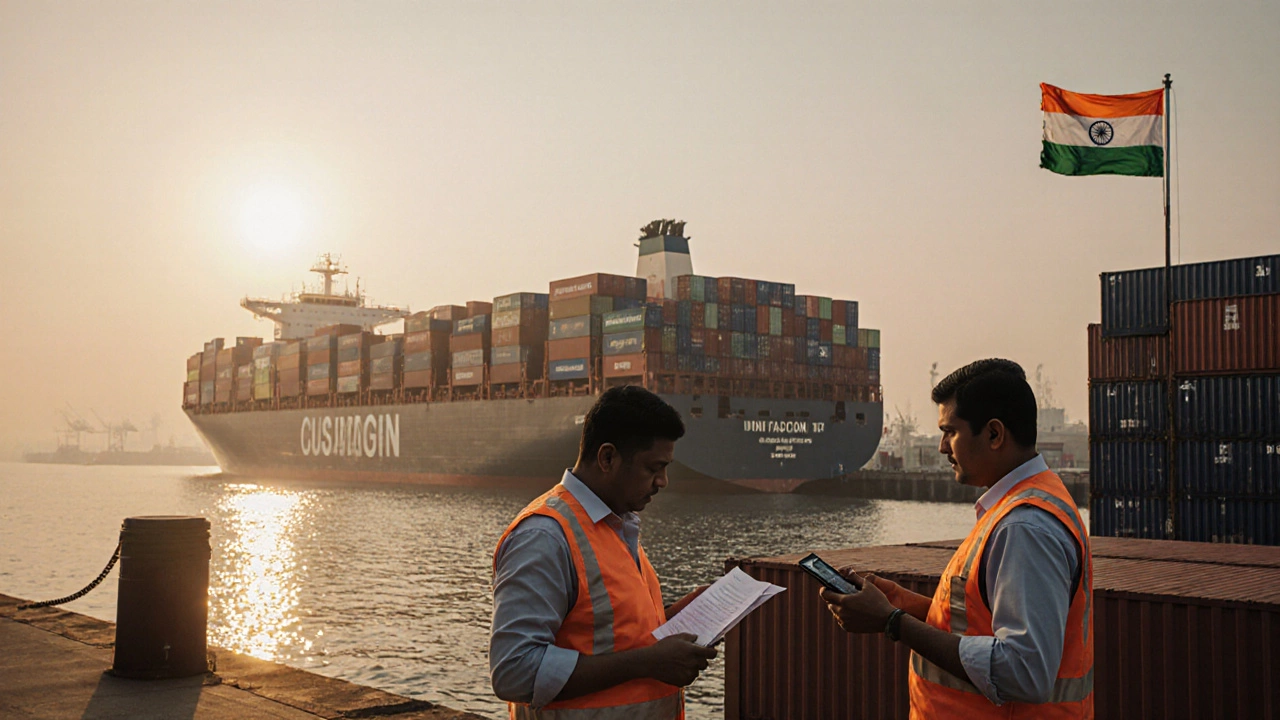India Export Prohibition Checker
When you’re planning to ship goods abroad, the first thing to check is whether Indian law lets you send that product overseas. Export Restrictions in India are the set of rules that forbid or tightly control the movement of specific items out of the country. Trying to export a prohibited item can lead to heavy fines, confiscation, or even criminal charges, so knowing the no‑go list is essential for any exporter.
Why India Controls Certain Exports
India’s export controls serve three main goals: protect national security, preserve cultural heritage, and meet international treaty obligations. The Foreign Trade Policy is the umbrella document released every five years that outlines what can and cannot be shipped abroad. Under this policy, the Directorate General of Foreign Trade (DGFT) acts as the administrative arm that issues licences, monitors compliance, and publishes the latest prohibited‑goods list. Together with the Customs Act 1962 provides the legal framework for customs enforcement and penalties, exporters have a clear regulatory chain.
Categories of Items That Cannot Be Exported
Below is the practical breakdown of what you absolutely cannot ship out of India. Each category references the specific order or act that makes the ban enforceable.
- Strategic and Dual‑Use Goods - Items listed under the Strategic Goods (Control) Order (SGCO) covers defense equipment, advanced electronics, and encryption technology. Export of weapons, ammunition, radar systems, and high‑grade cryptographic software is outright prohibited without a special licence.
- Cultural Heritage and Antiquities - The Cultural Heritage Preservation Act bars export of ancient manuscripts, sculptures, and any artefact over 100 years old without export permission. This includes temple idols, historic paintings, and rare coins.
- Wildlife and Environmental Products - India is a signatory to CITES (Convention on International Trade in Endangered Species). Any product derived from endangered species-tiger skins, elephant ivory, certain pangolin scales, and even specific hardwoods-cannot leave the country.
- Pharmaceuticals and Controlled Substances - The Pharmaceuticals (Control) Order restricts export of narcotic medicines, certain antibiotics, and raw drug precursors. Export of opiates, amphetamines, and raw morphine is illegal.
- Hazardous Chemicals and Pesticides - Under the Hazardous Substances (Control) Order the government bans export of highly toxic chemicals, organophosphates, and certain industrial solvents. This includes substances like cyanide, mercury compounds, and some ozone‑depleting agents.
- Gemstones and Certain Minerals - Raw, uncut diamonds and certain mined minerals (e.g., bauxite, iron ore in restricted zones) are barred from export unless a specific quota licence is granted. The Minerals (Export) Order specifies which ores require a licence and which are outright prohibited.
- Agricultural Seeds and Plant Material - Export of onion and garlic seeds, as well as certain high‑yield varieties of wheat, is prohibited during domestic shortage periods. The Plant Quarantine (Regulation) Order controls movement to prevent pest spread.
- Currency and Monetary Instruments - The Reserve Bank of India restricts export of Indian Rupee notes and coins beyond a minimal amount. Export of foreign exchange in excess of USD 5,000 per person without declaration is also illegal.
How to Verify Whether Your Product Is Prohibited
Before you file an export shipment, run through these steps:
- Visit the DGFT’s official portal and locate the latest Prohibited Export Items List. The list is updated quarterly.
- Cross‑check the product’s HS (Harmonized System) code against the Customs Tariff Act which embeds the prohibited‑goods matrix.
- If the item falls under a strategic or dual‑use category, request a no‑objection certificate (NOC) from the DGFT’s Strategic Goods Licensing Division.
- For cultural, wildlife, or plant products, obtain an export permit from the respective ministries (Ministry of Culture, Ministry of Environment, Ministry of Agriculture).
- Document the verification process in your export file-customs officers often ask for proof of compliance.

Penalties for Violating Export Bans
Breaking any of the restrictions triggers severe consequences:
- Monetary fines ranging from INR 50,000 to INR 5,000,000 per violation.
- Seizure of goods - Customs can confiscate the entire shipment and hold it for up to 30 days.
- Criminal prosecution - Under the Indian Penal Code sections 379 and 420 cover fraud and cheating related to illegal exports, offenders may face up to 3 years imprisonment.
- Export licence revocation - Future licence applications may be denied for a period of 5 years or more.
Quick Checklist for Exporters
Keep this cheat sheet handy when you prepare a shipment:
| Step | Action | Document Required |
|---|---|---|
| 1 | Identify HS code | Product specification sheet |
| 2 | Search DGFT prohibited list | Screen capture or printout |
| 3 | Check strategic‑goods status | NOC from DGFT (if needed) |
| 4 | Obtain sector‑specific permits | Culture/Environment/Agriculture licence |
| 5 | Prepare export declaration | Customs invoice, packing list, licence copies |
Common Misconceptions
Many newcomers think that “if I can sell it domestically, I can export it too.” That’s false. For example, raw diamonds can be bought in India but cannot be shipped abroad without a licence because they fall under the Precious Stones (Export) Regulations. Another myth is that “small quantities are okay.” Even a single gram of tiger bone is a violation under CITES.

What to Do If You’ve Already Shipped a Prohibited Item
Act quickly:
- Contact the exporting customs office and disclose the error.
- File an voluntary surrender request-authorities may reduce penalties for cooperation.
- Engage a customs broker or legal counsel experienced in Indian export law.
- Review internal processes to prevent repeat mistakes.
Future Trends in Indian Export Controls
India is tightening controls on technology and data‑related goods as part of its digital sovereignty agenda. Expect new amendments to the SGCO that expand the list of encrypted software needing approval. Also, the upcoming National Wildlife Protection Amendment may add more flora species to the CITES list, affecting herbal export businesses.
Frequently Asked Questions
Can I export raw gold from India?
Yes, raw gold is allowed, but you must obtain a licence from the DGFT and comply with RBI’s foreign‑exchange regulations. Export of gold jewellery without a licence is prohibited.
Are antique textiles subject to export bans?
Antique textiles over 100 years old are considered cultural heritage. Export is only possible with a permit from the Ministry of Culture, otherwise they are prohibited.
What happens if I accidentally ship a prohibited pesticide?
Customs can seize the cargo and levy a fine. Prompt voluntary surrender and cooperation may mitigate the penalty, but a licence will be required for any future shipments of chemicals.
Do I need a licence to export software that uses encryption?
Yes, encryption software falls under the Strategic Goods (Control) Order. You must apply for a specific export licence from the DGFT's Strategic Goods Licensing Division.
Is there a limit on how much Indian Rupee I can take abroad?
You can carry a maximum of INR 25,000 in cash notes and coins without declaration. Anything above that must be declared to customs; otherwise, you risk seizure and fines.

